
Urakusatsu Tou
Kusatsu Onsen
Gunma
A moment of indulgence in body and soul

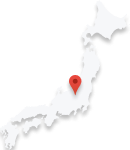
Kusatsu Onsen is one of Japan's most historic hot spring resorts located in Gunma Prefecture. It spreads at an altitude of 1,200 m. There are many hot springs in the central area called Yuhata, and the amount of natural gushing water of more than 32,300 liters per minute is the highest in Japan. Among them, the hot water of Yuhata is characterized by the scent of sulfur, and can be expected to have a beautiful skin and relaxing effect. It is a hot spring with such high efficacy that there is a legend that "there is no disease that does not work except for the disease of love". Since the source of Kusatsu Onsen is close to 50°, various measures have been taken to adjust the temperature to make it easy to bathe. For example, a long thin plate was placed in a hot spring to boil hot water and lower it to a certain temperature until it could be bathed. You can actually see this hot spring and the general public can participate.
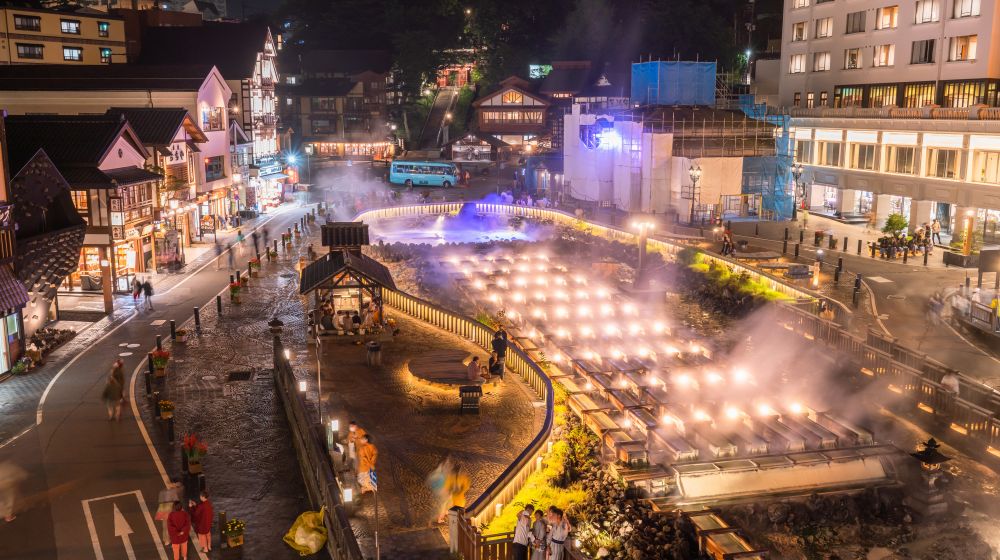
In recent years, it has become a popular place for foreign tourists. One ryokan introduced a system that uses QR codes to provide information about the facility in multiple languages. The hours of use of restaurants and public baths and information in the building are now displayed in 11 languages such as English and Chinese, and support has been enhanced so that even first-time visitors to Japan can stay with peace of mind.
The climate of Kusatsu is a highland town at 1,200 m above sea level, with an average annual temperature of 7°C. Even in the hottest months of July ~ August, the average temperature is 18°C, and it rarely rises above 30°C. Even in summer, you can stay cool and comfortable without knowing the heat. It snows in winter, so dress warmly when visiting.
The symbol in the center of Kusatsu Onsen, "Yubata". There is a spring of 4,000 liters per minute, and the water is always soaring. The spring water flows through seven gutters, lowers the temperature, and is sent to each facility. Over time, the components of the hot spring condense and precipitate in this gutter, and the flowers of the hot spring can be collected. It was named "Yuhata" because it is a field where hot water flowers can be collected.
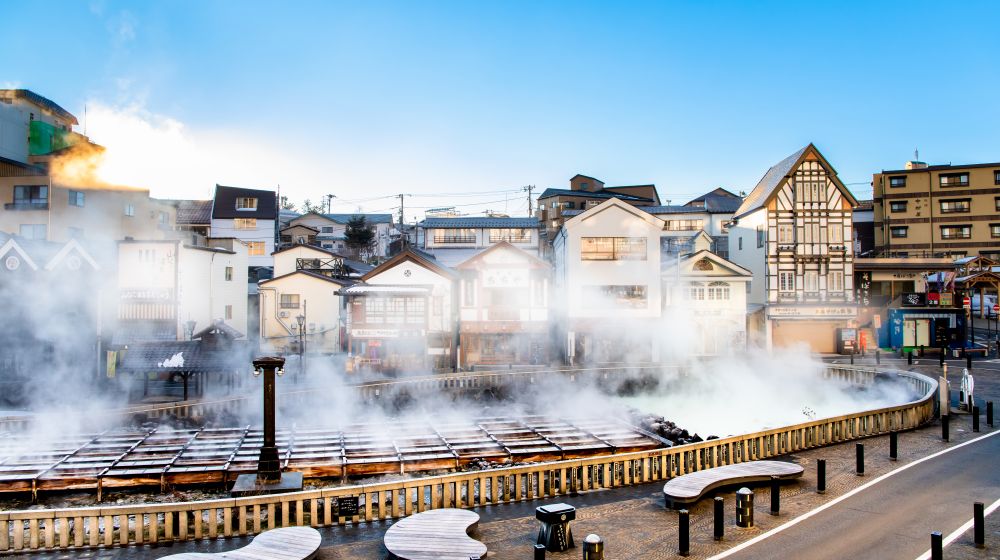
The area around the hot spring field is a sidewalk paved with tiles, and you can enjoy the appearance of old Japan. In the surrounding area, there is a shooting range, souvenir shops, and shops such as soba noodles and dumplings. It is a recommended area for a walk after the bath.
At the "Atanoyu" in front of Yubata, the "Yumomi Show" is held and you can see traditional culture. While singing "Yumomi Uta", stir the water vigorously with a long board. The light-filled facility is a two-story atrium with the scent of wood.
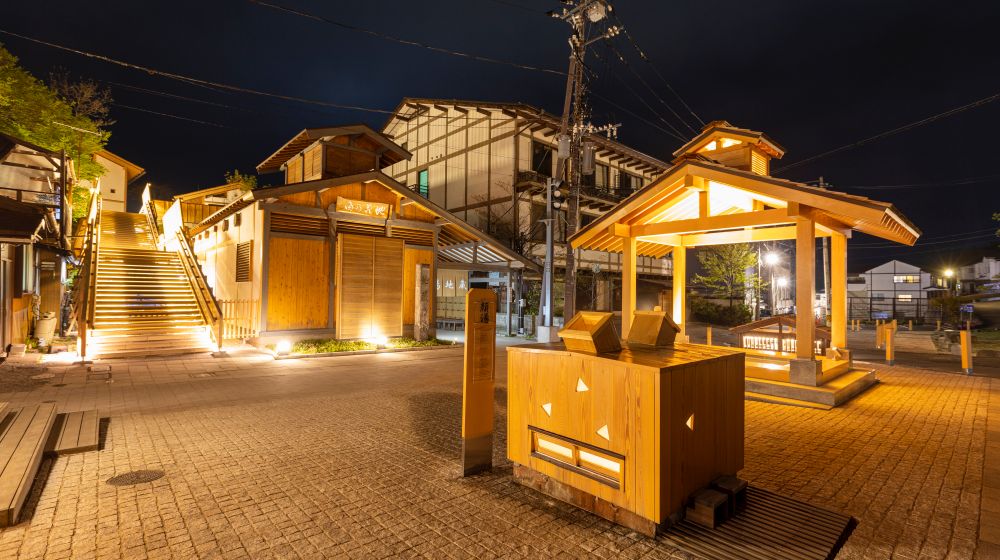
"Urakusatsu Jizo" is an area with a slightly calmer atmosphere, unlike the gorgeous hot spring fields. As soon as you walk from the bathhouse, you will first see the observation deck. From the observation deck, you can see the bathhouse from a different angle. If you go further in, you will find the communal bath "Jizo no Yu". The communal baths were originally hot springs that were open to local residents, but they are now available to tourists. Locals also use it, so let's enjoy it with minimum manners. For those who want to cherish their private space, we recommend the private hot spring facility "Traditional Yu Jizo". The time is fixed, so let's make a reservation first.

Jizo's hot water is cloudy and soft to the touch, and it is reputed to make the skin smooth. There are foot baths, face baths, and hand washing hot springs next to the Jizo hot spring, and you can easily enjoy the hot springs for free 24 hours a day. Face baths are rare even in hot spring resorts in Japan, and they are popular because they feel good as if their faces are packed. You can enjoy about 10,000 manga at "Mangado". You can also read at the attached café, so you can spend a relaxing time

<Shinkansen / Train and Bus>
Tokyo Station(Hokuriku Shinkansen) → Karuizawa(Kusatsu Kotsu / Seibu Kanko Bus) → Kusatsu Onsen (about 2 hours 20 minutes)
<Bus>
Ueno Station (Limited Express Kusatsu Shiman) →Naganohara Kusatsuguchi "JR Bus" → Kusatsu Onsen (about 3 hours)
<Bus>
Tokyo Station Yaesu Exit (Highway Bus) → Kusatsu Onsen Bus Terminal
<Shinkansen / Train and Bus>
Shin-Osaka Station (Tokaido Shinkansen) → Tokyo Station (Hokuriku Shinkansen) → Karuizawa (Kusatsu Kotsu / Seibu Kanko Bus) → Kusatsu Onsen (about 5 hours)
<Shinkansen / Train and Bus>
Nagoya Station (Limited Express Wide View Shinano) →Nagano Station (Hokuriku Shinkansen) → Karuizawa (Kusatsu Kotsu / Seibu Kanko Bus) → Kusatsu Onsen (about 5 hours)
The quality of the springs in Kusatsu Onsen is characterized by its strong bactericidal power. Sulfur is also the source of the popular souvenir "Yuhana". Kusatsu Onsen, which contains a lot of this, is a strongly acidic hot water with a PH value of 2.05. The 1-yen coin disappeared in about a week, and even the nail was tattered in 9 days.
However, this strong bactericidal power has also demonstrated an excellent effect on balneotherapy.
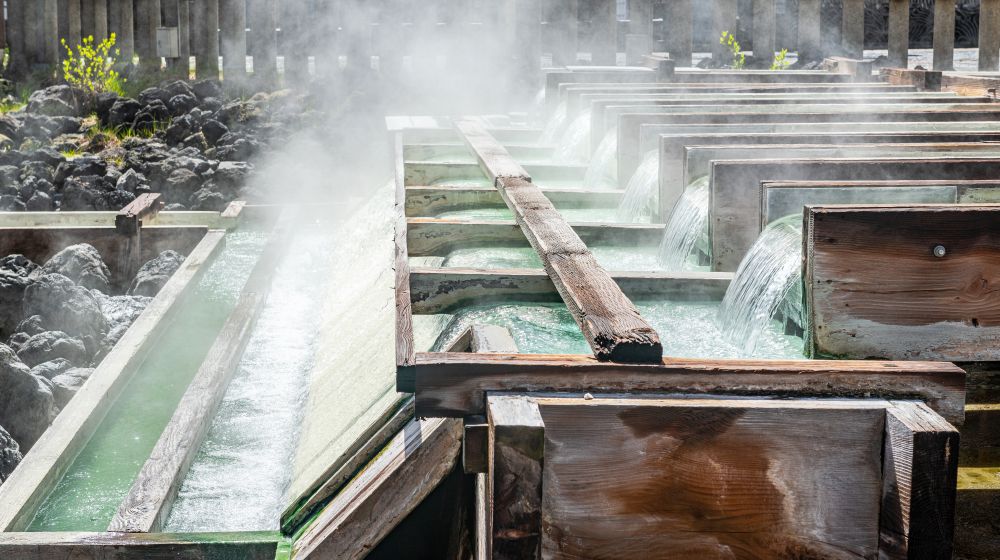
Indications include neuralgia, arthralgia, frozen shoulder, motor paralysis, joint stiffness, bruises, contusions, chronic digestive diseases, hemorrhoids, sensitivity to cold, recovery after illness, recovery from fatigue, health promotion, chronic skin diseases, arteriosclerosis, cuts, burns, frail children, chronic gynecological diseases, diabetes, hypertension, etc. Contraindications are acute diseases (especially in the presence of fever), active tuberculosis, malignant tumors, severe heart disease, respiratory failure, hemorrhagic disorders, severe anemia, and other diseases that are generally in progress, as well as people with hypersensitivity of the skin and mucous membranes (especially those with stoma hypersensitivity).
It is said that the number of sources of Kusatsu Onsen exceeds 100. Among them, there are six main sources. They are "Yubata Source", "White Flag Source", "Nishi no Kawara Source", "Jizo Source", "Nirikawa Source", and "Mandai Source". Depending on the facility, you can also enjoy your own hot spring.

You can easily enjoy Kusatsu Onsen at a day-trip hot spring called "Kusatsu Sanyu" that flows from the source. Each of the three facilities has its own characteristics. "Otaki no Yu" is one of the six hot springs, and you can enjoy the "Nirikawa source", which is said to contain a large amount of effective ingredients. There is a private hot spring, so families and couples can take a bath. The quality of the spring is acidic sulfur spring pH 2.1. As for efficacy, it is expected to be effective for neuralgia, joint pain, bruises, sprains, burns, chronic digestive diseases, recovery period after illness, beautiful skin, chronic gynecological diseases, etc.
.webp)
There are two types of "Gozanoyu", "Yuhata source" and "Mandai source", and it has a reputation for being able to compare the difference in texture. The quality of the spring at Yubata is acidic sulfur spring pH 2.08, and the quality of the spring at Mandai source is acidic chloride sulfate spring with a pH of 1.7. As for the efficacy, it is expected to be effective for neuralgia, joint pain, bruises, sprains, burns, chronic digestive diseases, recovery after illness, beautiful skin, chronic women's diseases, etc.
"Nishi no Kawara Open-Air Bath" boasts one of the largest open-air baths in Japan. You can enjoy the scenery of the four seasons, and it is lit up at night, so you can relax your body and mind. The source that springs from Mandai is a high-temperature source close to magma in Tsu Onsen, and its gushing temperature is very high at 94~5 degrees Celsius, and it has excellent bactericidal and anti-inflammatory effects.
There are various theories about the opening of Kusatsu Onsen. There is a theory of discovery by the legendary figure "Japan Takeson" about 1800 years ago, a discovery theory by the high priest of the Nara period, "Gyoki", and a discovery theory by Minamoto Yoritomo, who opened the Kamakura shogunate in 1193. In any case, it can be seen that the history of Kusatsu Onsen is old. Kusatsu Onsen has been loved by many historical figures. It was given the highest title at the time in the Edo period, and it is said that the shoguns of the Tokugawa family carried the hot water of Kusatsu Onsen to Edo Castle in present-day Tokyo to bathe in it. From the Edo period to the Meiji period, the traditional "yumomi" technique was established. A unique bathing method called "traditional bathing" was also created, in which bathing is divided into periods.
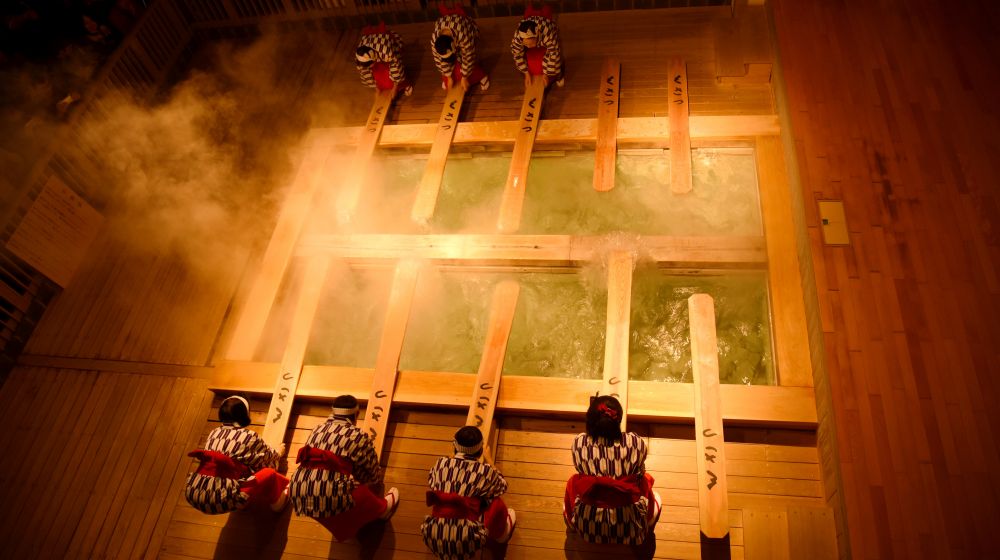
In 1878, a German physician, Dr. Belz, visited Kusatsu Onsen and has loved Kusatsu as his second home ever since. From the perspective of modern medicine, Dr. Belz announced to the world the unique strongly acidic spring quality of Kusatsu and its efficacy. Famous poets, writers, and artists have also inspired themselves to create in Kusatsu and create works related to Kusatsu, and Kusatsu Onsen has a charm that attracts many people.